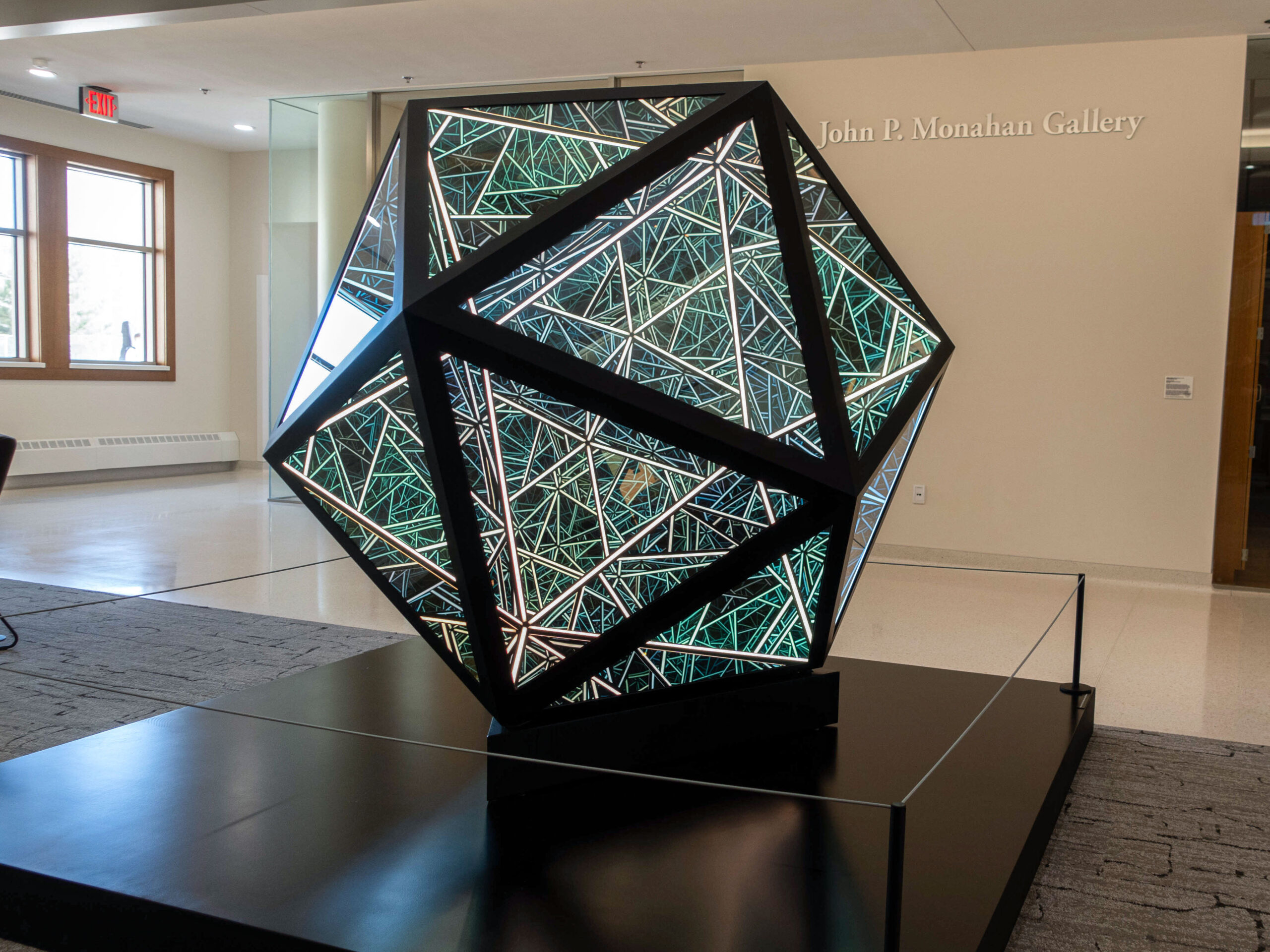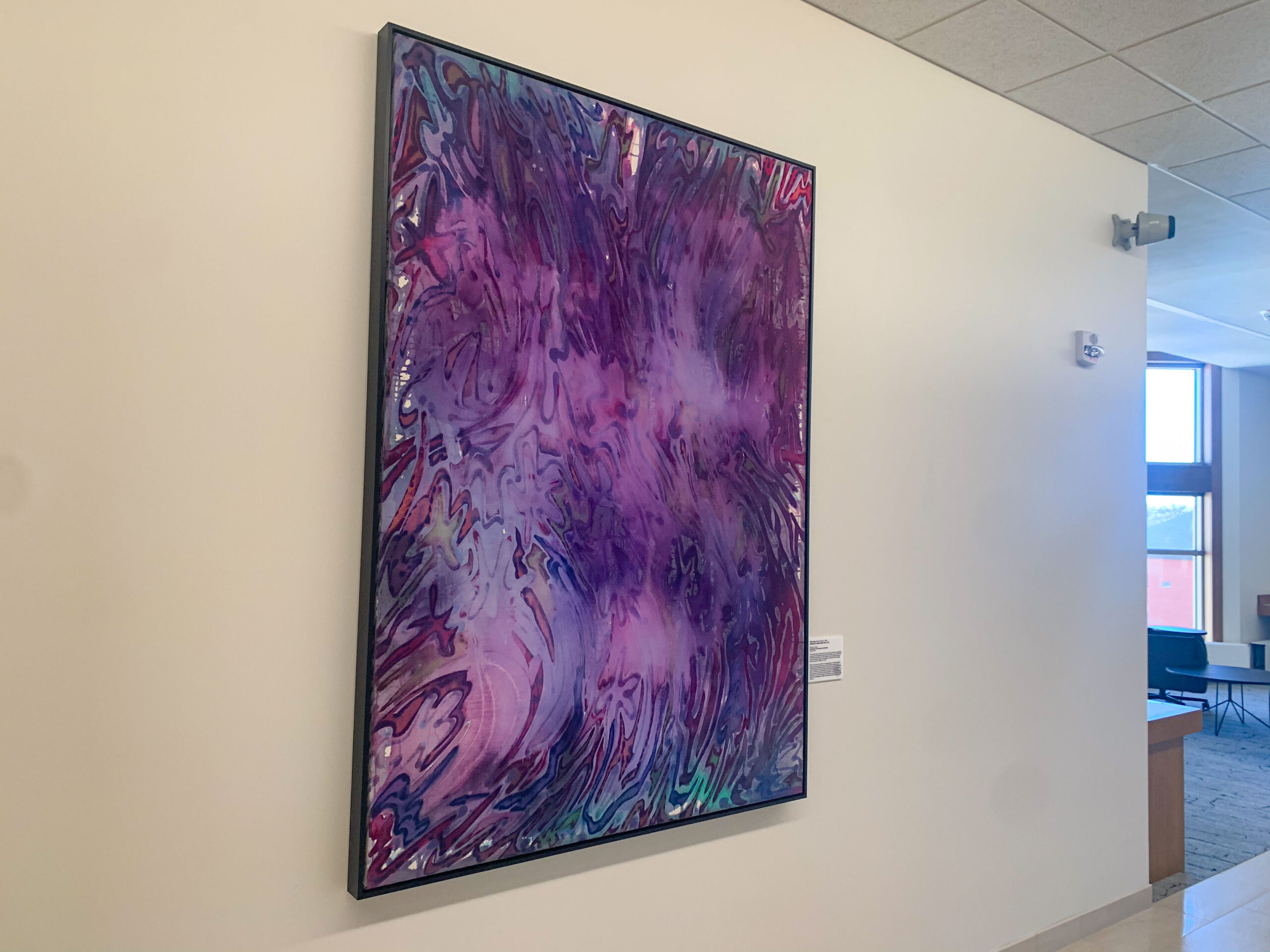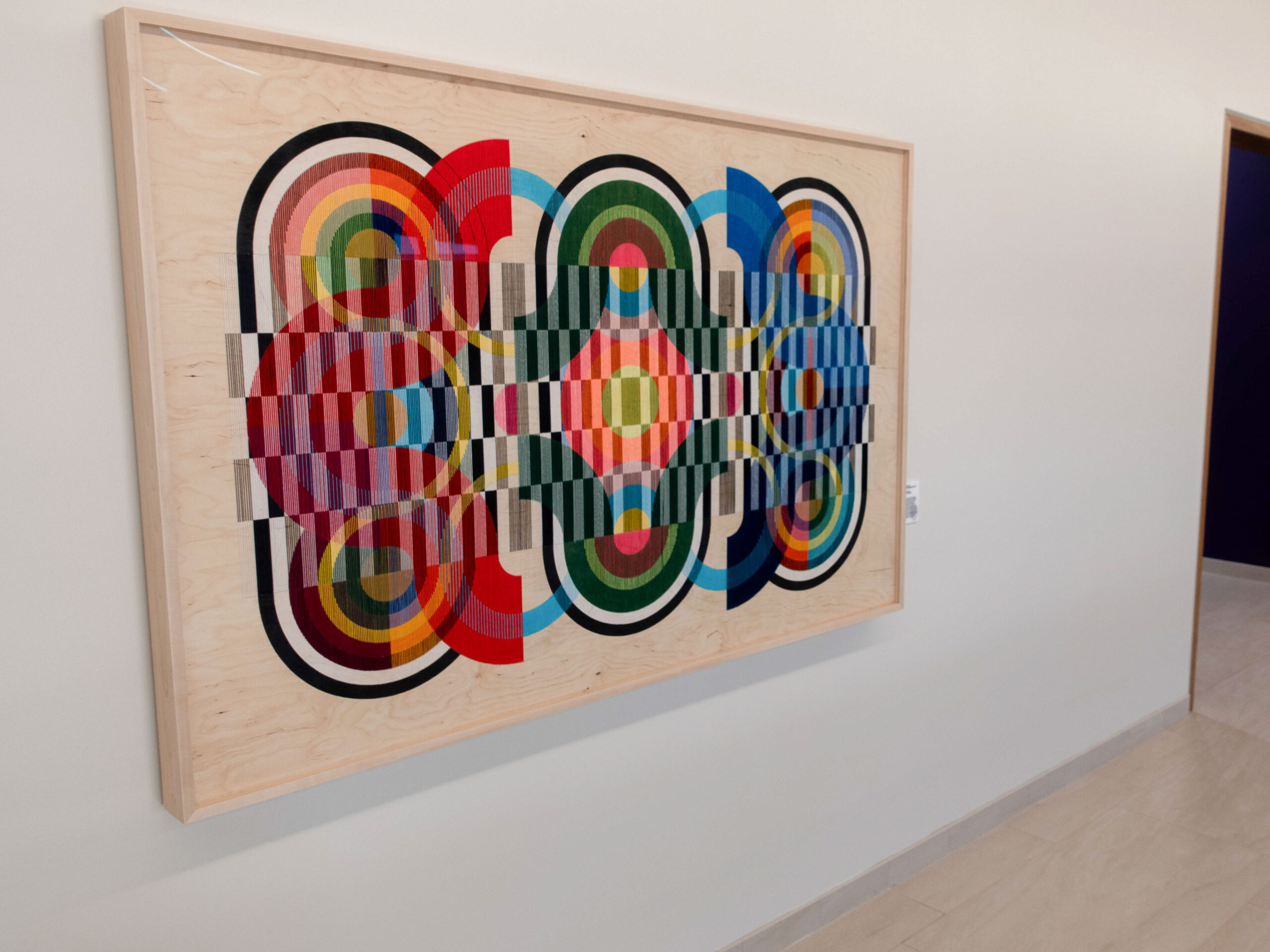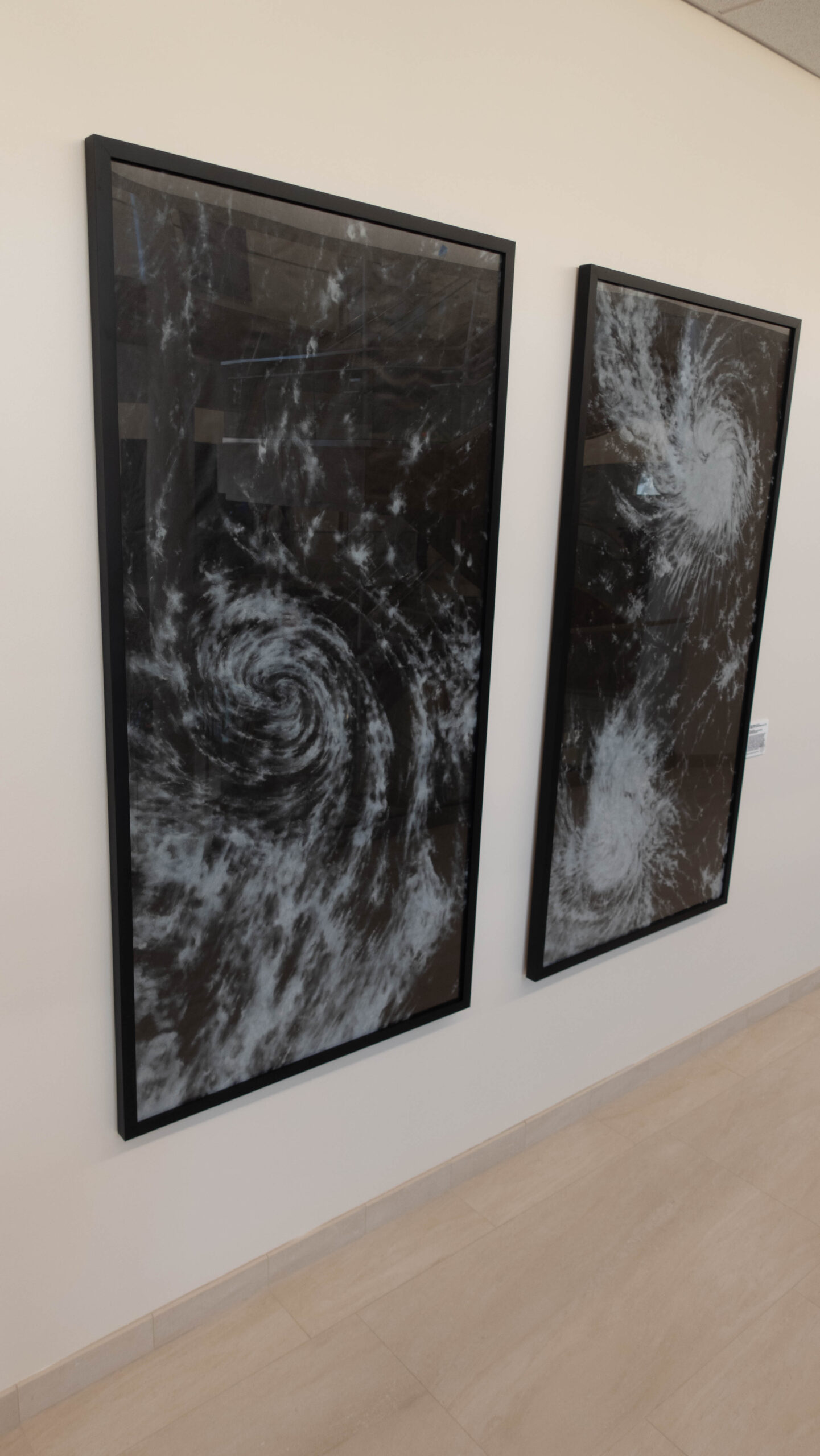The Schoenecker Center, which serves as the University of St Thomas’ new home for its science, technical, engineering, arts and math fields, opened its doors for classes on Monday, Feb. 5. The complex, which cost over 100 million dollars, features new facilities for integrative STEAM studies, including geology, multimedia, robotics and music.
For University Curator Marria Thompson, the Schoenecker Center meant something different: space to hang art, and lots of it.
“I was constantly creating packets, basically that was like, ‘Okay, here are our options, let’s narrow down from here,” Thompson said. “ … There’s a heavy curatorial hand just to make sure it meets our needs.”
The building currently houses five purchased works from local artists and one commissioned piece. Four more works have also been commissioned and will be placed on display in either late spring or early summer. Among the pieces is a 60-inch icosahedron sculpture, built with a combination of titanium, glass and LED bulbs, which is featured on the ground floor of the building’s atrium.
Also new is the John P. Monahan Art Gallery, which, located directly across from the icosahedron, will serve as the new home for the art history department’s latest events and exhibitions. The Monahan Gallery replaces the Department of Art History Gallery in O’Shaughnessy Educational Center; the latter will remain open through May 2024, according to the gallery’s website.
Another of the firsts ushered in by the Schoenecker Center came the welcome addition of an art budget, which Thompson says is typically not provided in similar cases. Thompson says that her first step in choosing which pieces would decorate the new space was to assemble a committee of faculty representing each of the disciplines present in the STEAM building alongside Dean of Arts and Sciences Bill Tolman, a process that she says lasted from late in the Spring 2023 semester until the end of August.
“I first asked them all to just go out there and look; look at art,” Thompson said. “What do you like? Who has art that you feel represents the STEAM environment and disciplines? And from that list I pulled ones that I knew would have art for sale or we could get a commission from and then supplemented a lot of artists that I’m familiar with, and from there as a committee we just narrowed it down.”
Thompson says the icosahedron was not one of the committee’s chosen pieces, instead being donated directly by Monahan, who was familiar with the artist, Anthony James’, previous work. Regardless, Thompson says she still had to consider the implications of the sculpture within the proposed space. In fact, she says, some had argued for a larger, 70-inch icosahedron, though Thompson decided against it because a larger sculpture would have been difficult to see around and blocked too much of the space.
She says that even the smaller version required an “interesting” installation process that saw the crated icosahedron brought in through the high bay and through the freight elevator to the atrium, where it was unloaded and moved onto its triangle pedestal with the help of Thompson, two art movers, several members of the facilities staff and a nearby construction worker.
“It was a slow, careful process,” Thompson said. “You can’t just easily pick it up and plop it down, so it took a lot of people.”
Thompson says that the new space has afforded the curators of the university art collection more than just an opportunity to choose new pieces; the Schoenecker Center has given the art collection a “proper” storage space for the first time in history, with paintings no longer residing in the Art History house on Cleveland Avenue.
“It’s one of those things that a lot of us in the department really nerd out about,” Thompson said. “(There’s) nothing super special about a rack you can pull out, but when your paintings and everything framed has been in a basement of a house, all leaning against each other, and you know that pressure is not good for art, this is really exciting.”
Every piece chosen to adorn the walls of the Schoenecker Center was selected or commissioned to visually align with one or more aspects of STEAM, Thompson says.
From pastel drawings of weather phenomena and paintings made on top of collaged financial newspapers to a wall-sized, metal-cut installation that will be installed in either late spring or early summer, Thompson says that each artist contributed their own stylistic and experiential expertise to visualize one or more disciplines. The Monahan gallery, which features a rotating exhibition, does not tie into these ideas, but Thompson says that the department hopes to incorporate interdisciplinary pieces into upcoming shows.
“When you’re doing a multi-person exhibition, how does the art connect with each other?” Thompson said. “Is it a thematic choice? Is it a visual choice? Do they not, but that’s the story: they’re opposing ideas? It’s kind of the same principle as doing a building, but slightly more flexible.”
Senior and gallery attendant at the Monahan Gallery Rose Johnson says that the addition of art to classroom space helps add creativity to otherwise “sterile” environments.
“I think it’s very cool if you can take a class and then see art that you can connect to that class in some way,” Johnson said. “I think that making a space brighter and more welcoming and more artsy, in many ways, for me, it helps me focus, and it keeps all classes from feeling so much like class.”
While the icosahedron was not a part of the committee’s chosen selection of pieces, Thompson says that it serves as a prime example of how traditional STEM models can be adapted into an artistic medium.
“I personally hope it makes people really realize that STEAM includes the arts, that the arts are present in this building, and it’s such an amazing piece in the fact that it’s so open to interpretation in what people see in it, get out of it, and I really love that,” Thompson said. “I love that you don’t have to just look at it and be like, ‘Oh, this is the message,’ so in that way I hope it inspires people to be creative.”
Johnson says that besides making for a convenient landmark to meet others, the icosahedron has an ability to “draw people in” and connect them to the purpose of the building.
“That piece in particular I really think works well because it does have all these angles and this geometry,” Johnson said. “It’s a lot of engineering that goes into it, and there’s a lot of engineering that goes on this building.”
Assistant Professor of Mathematics Alex Barrios says that the symmetric nature of the icosahedron is part of what makes it so pleasing to the eye. He says the icosahedron is a platonic solid, which means that all of its sides are identical — each of its 20 faces is an equilateral triangle. This makes it one of only five shapes to share this distinction alongside the tetrahedron, cube, octahedron and dodecahedron.
“It’s one of those nice things where for me as a mathematician, it’s making these parallels with, well, what’s one of the things that makes this object stand out is that no matter how hard we try, definitively it’s only one of these five objects that we can create where all the sides would be regular polygons,” Barrios said.
Physics professor Adam Green, who teaches junior and senior level optics courses, says that the illusion within the icosahedron is likely achieved through multiple two-way mirrors that partially trap the LED light inside the structure.
“It’s very common for it to be a piece of glass with a very thin aluminum coating like a two-way mirror that you would see in a police station for interrogation. That’s probably how it’s made,” Green said. “It’s just a very thin aluminum coating, and so if you’re standing in the dark room … you would make sure that the room you’re standing in is dark, so that the people in the brightly-lit room just see a mirror. But if you turn the light on, then all of a sudden they can see the light passing through the window.”
Green says that the properties of the glass also contribute to some of the quirks within the illusion.
“If you look deeper into the image, it looks bluer,” Green said. “It’s just because the reflective process depends a little bit on the color of light, and so some of the colors might be absorbed or reflected a little bit differently than other colors.”
The color of the icosahedron itself was chosen purposefully, Thompson says, though some in the new building had other ideas.
“There are certain people, who, when they see a work of art, they might be like, ‘Oh, you couldn’t do this in purple?’” Thompson said. “Even with the icosahedron, we picked the metal itself; we wanted it to be black … My stance is, I try to avoid too much purple because there’s already so much purple. I want to bring some other colors into the space.’”
With the new building bringing a new exhibition space, improved storage and, most importantly, new art, Thompson says that the art history department is seeking to promote both funding and awareness for their exhibitions going forward, with exhibition officers beginning conversations with potential donors like Monahan about continuing to support the visual arts at St. Thomas.
“We are really hoping this is a jumping-off point,” Thompson said. “ … We want more awareness. We want people to realize that we’re doing all these amazing programmings.”
Kevin Lynch can be reached at lync1832@stthomas.edu.





